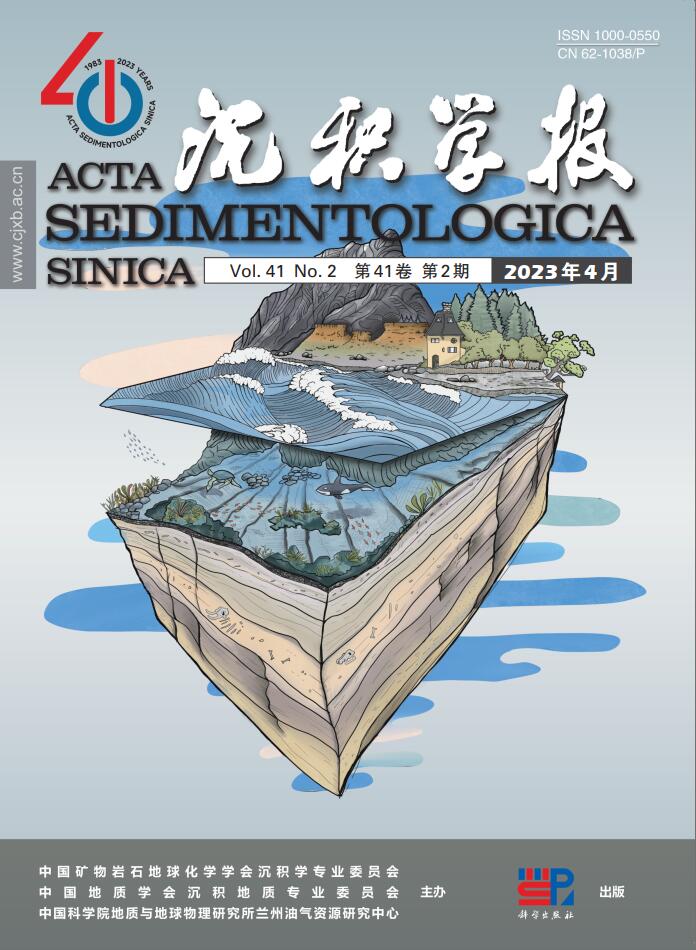HTML
-
四川盆地上三叠统陆源碎屑岩为重要的油气产层,该套地层在四川盆地各个地区均有广泛分布,长期以来对该套煤系地层存在多个命名混用的现象,在川西地区称为“须家河组”(含小塘子组),而在川中及川东地区则在相当一段时期内使用“香溪群”命名。自20世纪80年代以来,不少学者针对须家河组与香溪群的对比开展了大量工作[1⁃7],近年已不再使用“香溪群”这一名称,并基本形成了将须家河组划分为六段的共识,其中小塘子组相当于须一段,但川中及川西地区须家河组内部层段的对比仍存在较大分歧。梁恩宇[1]认为川中地区从须四段开始接受沉积,下部缺失须一段—须三段沉积,上部缺失须六段沉积;张健等[4]认为川中地区须一段—须五段与川西地区均能对比追踪,但须六段在川西地区不发育,田继军等[6]持类似观点,但认为在川西地区仅缺失须六段上部沉积;郑荣才等[5]认为川中地区须二段沉积时期开始接受沉积,须二段—须五段厚度自东向西逐渐增厚,川西地区缺失须六段沉积;一些学者认为川中地区发育须一段沉积,随后构造抬升导致地层不同程度的缺失[2⁃3,7],但何鲤等[3]认为川中地区须三段开始再次接受沉积,而罗启后[2]、李剑波等[7]则认为川中地区须四段沉积期才再次接受沉积。
可以看出,四川盆地上三叠统虽然经历多年的研究,目前仍未形成多方认可的统一地层划分方案。地层划分的分歧主要归结为以下几个问题,即川中地区是否发育须一段、川中地区须家河组何时开始沉积以及川西地区何时开始结束沉积?川中和川西地区须家河组地层划分不统一的原因主要是岩石地层命名的影响和资料限制,同时也受到历史沿革等多重因素的制约,地层划分存在的问题直接影响了对晚三叠世四川盆地沉积充填模式的认识,进而对该区油气勘探带来影响。川中地区作为四川盆地构造分区的衔接带,位于全盆地岩相古地理恢复的重要位置。本文根据横跨川西—川中地区的地震大剖面,结合野外露头、岩心、测井解释成果及岩石薄片分析等资料,对川西—川中地区上三叠统地层发育特征、物源体系及沉积充填特征进行了研究,对全盆地上三叠统地层划分、重新认识晚三叠世四川盆地性质和构造演化具有重要影响。
-
中三叠世,川中地区主要为碳酸盐岩台地环境,发育蒸发台地、局限台地及开阔台地等沉积相类型,川西地区则主要发育台缘斜坡[8]。中三叠世末印支早期运动引起的基底抬升,导致四川盆地不同地区雷口坡组遭受不同程度的剥蚀[9],其中都江堰—营山一带地层雷口坡组剥蚀量较小,雷四段保存较好,而泸州—重庆一带雷口坡组完全被剥蚀(图1),龙门山“岛链”将上扬子地区分隔为西部的特提斯广海和东部的古海湾或残留海盆[10⁃11]。
印支早期运动形成的雷口坡组顶部古喀斯特地貌特征及龙门山造山带向东逆冲,决定了四川盆地上三叠统呈“箕状”向东减薄的沉积充填特征[4,12]。现今龙门山地区位于初始前陆盆地西侧和水下逆冲楔前缘,因继承性海水覆盖,上三叠统卡尼阶马鞍塘组与雷口坡组之间为连续沉积,龙门山以东地区马鞍塘组与雷口坡组为平行不整合接触,马鞍塘组向东、向北上超于雷口坡组之上[13]。晚三叠世四川盆地由卡尼期和诺利期局限残留海相沉积逐渐向瑞替期河流—三角洲沉积体系演化[5,11,14⁃22]。晚三叠世四川盆地经历了至少3次区域性构造抬升和剥蚀,形成了“小塘子组/马鞍塘组”、“川西须二段/小塘子组”以及“川西须四段/须三段”之间的3个平行不整合或微角度不整合[12,23],其中“安县运动”[24]是导致四川盆地完全演化为陆相盆地的关键事件[25]。
-
已有研究一般将川西—川中地区上三叠统划分为马鞍塘组及须家河组,其中须家河组进一步细分为6个岩性段,小塘子组相当于须一段。通过井—震合成记录标定结果发现,川中—川西地区侏罗系底部表现为2~3个稳定强波峰反射,第二个强波峰反射解释为上三叠统顶;上三叠统底部表现为双波峰稳定强反射,其第一相位强波峰解释为雷口坡组顶,上三叠统顶、底界较为清晰(图2a),易于识别。
选取位于川西—川中过渡带的JH5井钻井分层为标准,根据地震反射特征,对须家河组内部小层进行了对比和追踪,并根据内部反射特征将中石油分层须二段(SY-T3x2)以下、雷口坡组之上地层进一步细分为7个反射层,从底到顶依次为1-1、…1-7。其中川西地区1-1及1-2反射层在地震剖面上表现为“宽波谷、弱反射”地震剖面特征,分别对应于马鞍塘组(T3m)及小塘子组(T3xt),川中地区缺失1-1及1-2反射层;1-3~1-6反射层在川西地区地震反射特征表现为“不稳定中频变强振幅反射组合”的反射背景,局部(如1-3及1-4反射层)表现为“低频强振幅短轴反射”特征,反映整体泥岩背景下局部发育厚层的三角洲砂体;而在川中地区该段则表现为“中低频较稳定强振幅反射”组合的地震反射特征,反映砂泥岩互层为主的岩性组合特征(图2b)。1-3~1-7反射层包括中石化分层的须二段(SH-T3x2)及须三段(SH-T3x3),总体呈自西向东逐层上超的特征。
由于历史原因和资料的限制,长期以来中石化和中石油系统对须家河组内部分层的表述存在不同的涵义,上三叠统中石化分层(基本与龙门山野外露头传统分层方案一致)和中石油分层存在较大差异。根据井—震标定,整体来看,上三叠统顶、底部地层分层一致,须家河内部地层差异大(图3)。川西地区中石化分层须四段(SH-T3x4)对应川中地区中石油分层须二段(SY-T3x2);中石化分层须五段(SH-T3x5)对应川中地区中石油分层须三段(SY-T3x3)、须四段(SY-T3x4)及须五段(SY-T3x5);小塘子组及马鞍塘组仅在川西地区发育,在川中地区缺失(图4a),SY-T3x3、SY-T3x4、SY-T3x5、SY-T3x6在川西地区有不同程度的缺失,自南东向北西方向须家河组顶部地层削蚀量逐渐增大,都江堰—安县—剑阁—旺苍一线以西及其以北地区缺失SY-T3x3及其上部的须家河组(图4b),因此川西地区诸如广元工农镇、彭州狮山等剖面中出露的须家河组应该为SY-T3x3之下的地层。根据川西—川中地区上三叠统内部发育的4个不整合面及大型冲刷面(T3xt/T3m、SH-T3x2/T3xt、SH-T3x4/SH-T3x3、SY-T3x4/SY-T3x3),结合沉积旋回特征,可将川西—川中地区上三叠统划分为5个长期层序。其中川西地区从LSC1开始接受沉积,主要发育LSC1~LSC4,而川中地区从LSC3开始接受沉积,主要发育LSC4及LSC5(图3)。
-
岩相古地理恢复结果表明,晚三叠世四川原型盆地东达思南县、南至黔西县,四川盆地同时受周边多个古陆(结晶基底出露)和古隆起(沉积岩出露)的影响和控制。其中东部物源体系包括鄂西古陆、雪峰古陆及梵净山古陆,南部物源主要来自黔滇古隆起、康滇古陆及峨眉古陆,西部物源主要来自摩天岭古陆、彭灌杂岩及龙门山地区(晚三叠世为同沉积隆升区),北部物源主要来自米仓—大巴古陆(图5)。从区域地质资料来看,盆地周缘古陆均能提供花岗岩、花岗片麻岩、玄武岩、浅变质岩、碎屑岩及碳酸盐岩等物源,而南部黔滇古隆起只能提供沉积岩和浅变质的沉积岩,岩屑组合具有明显分区性。

Figure 5. Distribution characteristics of the main provenances in the Late Triassic Sichuan prototype basin①
晚三叠世,四川盆地西部—中部地区主要受西部和东部物源体系控制,其中西部物源体系以富“钙”为特征[26],碳酸盐岩岩屑较高(图4c,d、图6a),可称为“钙屑砂岩”,而东部物源体系(包括东南部、东部及东北部)则以贫“钙”为特征[27⁃28],砂岩中以碎屑岩岩屑、变质岩岩屑及岩浆岩岩屑为主(图4c,d),富含石英、石英岩、千枚岩、泥岩及喷出岩岩屑(图6b,c),可称为“硅质砂岩”。“钙屑砂岩”通常具有较高的电阻率值,而“硅质砂岩”测井曲线一般表现为低阻的特征,代表西部物源的高阻砂体与东南部物源体系的低阻砂体在射洪附近金华—秋林地区交汇(图7a)。

Figure 7. Characteristics of the provenance intersection in the western and central Sichuan transition zone
地震剖面上东、西物源体系的交汇特征同样有清晰的反映。FS1井—QL2井SY-T3x2(LSC4下部)内部地震反射较强、同相轴较为稳定;Q2井—Q101B井SY-T3x2内部地震反射相对较弱,但仍可连续追踪;Q2井—Q101B井SY-T3x2在QL3井附近呈楔状超覆于FS1井—QL2井SY-T3x2之上(图7b),与测井解释的联井对比剖面所示完全一致(图7a),西部物源体系与东南部物源体系呈此消彼长的分布态势。
-
中三叠世末期,印支早期强烈的构造运动造成四川盆地及其周缘地壳整体抬升,晚三叠世卡尼期,上扬子区仅川西和黔西南地区发育两个残留海盆[11]。马鞍塘组沉积时期,川西坳陷为与古特提斯大洋局部沟通的古海湾[10],主要发育碳酸盐岩缓坡及有障壁海岸沉积[29⁃32],局部可能存在少量三角洲沉积,形成了一套泥微晶灰岩、粒屑灰岩、粒泥灰岩、礁灰岩、泥岩及粉砂岩等岩性组合。
小塘子组沉积时期,川西地区开始大量接受陆源碎屑的注入,海相三角洲、有障壁海岸及陆源碎屑陆棚均有不同程度的发育[21,30⁃32],形成了一套砂岩、粉砂岩和泥岩互层的以陆源碎屑岩为主的沉积(图8a~c)。

Figure 8. Rocks and sedimentary structures of the Late Triassic in the western and central Sichuan Basin
SH-T3x2及SH-T3x3沉积时期,川西地区以大量发育三角洲为特征(图8d、图9a),主要为砂岩、粉砂岩、泥岩互层,局部发育炭质泥岩及煤线。SH-T3x3沉积晚期,川西坳陷龙门山前带开始发育少量扇三角洲沉积,以分选较差的砂质砾岩为识别标志(图8e)。四川盆地SH-T3x2及SH-T3x3地层中菊石及舌形贝等海相生物化石的发育[2,4,12,15],表明这一时期四川盆地仍与外海局部沟通。

Figure 9. Sedimentary facies distribution map of the Xujiahe Formation in the western and central Sichuan Basin
SH-T3x3沉积末期,“安县运动”导致龙门山大幅抬升以及四川盆地与外海的彻底隔绝,四川盆地进入陆相沉积时期。SY-T3x2及SY-T3x3沉积时期,川西地区以发育冲积扇—扇三角洲—湖泊沉积体系为主(图9b,c),以发育厚层—块状、分选较差、粒径较大的砾岩为特征(图8f~h);而同期川中地区主要发育河流—三角洲—浅湖沉积[18⁃20,33],以大套砂、泥岩互层为主,仅含极少量分选及磨圆较好的薄层细砾岩(图8j)。
SY-T3x4至SY-T3x6沉积时期,川西—川中地区以发育三角洲—湖泊沉积体系为主[33],可见蕨类及银杏等陆生植物化石(图8i),整体以大套砂岩与泥岩、粉砂岩互层为特征(图8k,l),其中SY-T3x4及SY-T3x6以发育辫状河三角洲为主,而SY-T3x5则主要发育曲流河三角洲(图9d~f)。该沉积时期大部分地区沉积水体较浅,湖盆中心位于川西南一带。
-
印支早期运动之后,海平面再次上升,在川西坳陷马鞍塘组沿雷口坡组古喀斯特面自西向东逐渐上超(图10、图11a),最远上超至射洪一带,该期陆源碎屑主要来自西北部摩天岭古陆及东北部米仓山—大巴山一带。马鞍塘组沉积末期,海平面再次下降,海岸线向西南退超至成都一带(图4a、图11b),在马鞍塘组和小塘子组之间形成了平行不整合面[30⁃31],该沉积时期陆源碎屑仍然主要来自四川盆地西北部摩天岭古陆及东北部米仓山—大巴山古陆(图11b)。

Figure 10. The development patterns of strata and sand bodies cross TS1 & PL8 (Fig.b was compiled according to the interpretation results of the well logging and seismic section)
小塘子组沉积时期,海平面再次上升,地层再次向东上超至简阳—射洪—旺苍一带、向北上超至广元一带,在工农镇剖面发育厚达170 m的有障壁海岸—陆棚沉积,而同期川中及川东的广大地区尚未接受沉积(图11c)。从工农镇须家河组建组剖面来看,小塘子组沉积末期存在一期大幅度的海退,导致该区基底大幅度抬升,SH-T3x2下部的河流相直接覆盖于小塘子组陆棚沉积之上[34],沉积范围主要限于川西地区,以发育辫状河—辫状河三角洲沉积为特征(图11d)。小塘子组与SH-T3x2之间的不整合面在川西彭州—什邡一带同样明显,但横跨川西—川中地区的6条格架地震剖面的解释成果表明,小塘子组沉积之后的SH-T3x2仍然总体表现为自西向东的上超(图2、图4a),因此推测小塘子组与SH-T3x2之间的不整合面可能主要与龙门山的隆升有关,小塘子组顶部地层的剥蚀主要限于龙门山前带。
SH-T3x2至SH-T3x3沉积时期,海平面持续上升,地层继续自西向东上超,至SH-T3x3沉积晚期,川中及川东地区均开始接受沉积。随着陆源碎屑的大量注入,三角洲开始大量发育,SH-T3x3沉积时期川西坳陷龙门山前局部发育扇三角洲沉积(图11e),川中—川西过渡带是东、西部物源体系的主要交汇区(图7,10)。SH-T3x3沉积末期发生的“安县运动”导致四川盆地不同程度的抬升,SH-T3x3顶部地层遭受不同程度的剥蚀,SH-T3x3与SY-T3x2接触关系在西部龙门山前带表现为平行不整合(图8f)或微角度不整合(图8h),而在川中地区则主要表现为大型冲刷面[12]。SH-T3x2与SH-T3x3沉积时期砂体主要发育于川西坳陷及川西—川中过渡带,川中隆起带以沼泽化的泥岩或碳质泥岩夹煤线为主。
“安县运动”导致龙门山完全抬升[35],四川盆地完全演化为陆相湖盆,龙门山的大幅抬升向川西坳陷提供了大量粗碎屑物质,导致SY-T3x2沉积时期川西地区以发育冲积扇—扇三角洲沉积为特征,而同期川中地区则以广泛发育的三角洲为特征(图9b、图11f),在射洪一带钻揭显示该区同期发育辫状河三角洲沉积,既发育反映西部物源的高阻“钙屑砂岩”,亦有来自东南部物源体系的低阻“硅质砂岩”(图7),明确指示这一时期东南部物源已经向川西坳陷提供大量陆源碎屑(图7,10)。SY-T3x3沉积时期为湖侵期,川中—川西大部分地区以发育湖泊沉积为主,三角洲发育规模变小,同期梓潼—剑阁一带发育扇三角洲沉积(图9c),表明这一时期龙门山北段仍然存在强烈的构造活动(图11g),并导致川西北地区缺失该段沉积(图4b)。
SY-T3x4沉积时期四川盆地再次进入构造活跃期,特别是川东北米仓山—大巴山强烈的构造活动在山前带形成了巨厚的粗碎屑沉积[17],但川西—川中地区仍主要受西部和东南部物源体系控制,同时受东北部物源影响,以发育辫状河三角洲沉积为主(图9d、图11h)。SY-T3x5沉积时期,四川盆地周缘构造活动减弱,沉积范围有进一步向东南缩小的趋势,研究区以发育湖泊沉积为主,局部发育少量曲流河三角洲沉积(图9e、图11i)。SY-T3x6沉积时期,四川盆地周缘构造活动再次增强[17],川西坳陷绝大部分地区缺失该段沉积,川中地区以发育辫状河三角洲为主(图9f、图11j)。
-
(1) 晚三叠世卡尼期,川西残余海盆开始接受沉积,形成了马鞍塘组碳酸盐岩缓坡及有障壁海岸沉积为主的沉积体系,卡尼晚期的海平面下降形成了马鞍塘组/小塘子组之间的平行不整合,诺利期再次海侵,在川西坳陷发育小塘子组有障壁海岸—陆棚沉积体系。
(2) 诺利期/瑞替期之交,构造隆升导致川西龙门山前带小塘子组顶部遭受侵蚀,但川西坳陷主体沉积区未受明显影响,瑞替期须家河组沉积继续自西向东上超形成了SH-T3x2及SH-T3x3海相三角洲沉积体系,SH-T3x3沉积晚期川中开始接受沉积。
(3) “安县运动”导致龙门山的大幅隆升以及四川盆地与外海完全隔绝,形成了SY-T3x2沉积时期川西以冲积扇—扇三角洲为特征,川中以河流—三角洲为主的沉积格局,此后伴随龙门山的不断隆升,须家河组沉积范围不断向东缩小。
(4) 川西—川中地区主要受西部和东南部物源体系控制,伴随西部龙门山造山带的不断隆升,物源交汇带(湖盆中心)有自西向东逐渐迁移的趋势。













 DownLoad:
DownLoad:









